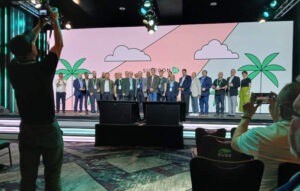 I don’t think the unnamed and unknown blogger who writes under the banner of The VAR Guy would argue with me if I were to say that over at his site it’s all about the money. That’s not a bad thing. The value added resellers, the VARs who are his readers, would expect nothing else.
I don’t think the unnamed and unknown blogger who writes under the banner of The VAR Guy would argue with me if I were to say that over at his site it’s all about the money. That’s not a bad thing. The value added resellers, the VARs who are his readers, would expect nothing else.
These are guys and gals to whom hardware and software are all part of the same packet. This is the crowd who couldn’t care less about the usability of, say GNOME, for the average home user and who might even be tempted to look for loopholes in the GPL, because it would be easier to make money with free software if it wasn’t free. In other words, these are folks who’ve traditionally mainly stood firmly in the proprietary camp, where the rules for resellers have been more clearly defined. These are the dudes and dudettes who make RMS very wary whenever he sees them coming our way.
But I generalize. VARs are also often on our side.
If not for VARs, there would never have been a Red Hat. When you think about it, Red Hat got their start as a value added reseller pushing Linux and they depend on VARs today to move their products. If VARs had never worked with open source, IBM would never have dropped a billion bucks into Linux development in order to make the OS ready to run on their iron so they could offer Tux as an option alongside AIX. If VARs always held closed minds to open source, McNealy and Schwartz would never have open-sourced Java, Solaris or the Star Office code–nor would they have purchased MySQL.
True, VARs have traditionally chosen to go the proprietary route, which they’ve considered better paved and better marked, but they’ve not been unwilling to take a chance and go down the unmarked gravel road of open source. Mainly, VARs just want to make money, which makes them a pretty agnostic lot. They’ll worship at the cathedral or the bazaar–or anywhere else where the cash register is liable to go ka-ching.
| [yop_poll id=”12″] |
These are the people the writer known as The VAR Guy serves. He’s not looking at operating systems in order to tell folks what distro might possibly work on an old 486 that’s collecting dust in the garage. Nor is he likely to write an article bashing the likes of Microsoft’s and Oracle’s reliance on proprietary formats and vendor lock-in instead of embracing open standards. But he might write an article about the success some vendors have been having pitching an open source enterprise stack’s use of open formats with no vendor lock-in.
In other words, he’ll cover both the goose and the gander. He’ll write about anything the VARs can turn into moolah. Again, the VARs are all about the ka-ching, ka-ching. They don’t pretend anything else and there’s nothing wrong with that as long as it’s done ethically and honestly. It’s called sales. It’s how a lot of fathers and mothers feed their children and put them through school.
I wrote about The Var Guy back in September of 2011, when the site was sold to Penton Media. I wondered aloud on these pages if this would mean an end to fair treatment of FOSS news by this faceless, anonymous blogger. In those days he reported a little on FOSS products, and he was fair, but it was mostly Microsoft, Oracle and the usual suspects that he pitched to his readership. I didn’t hold that against him. Again, that’s where the money was to be found.
About a week after that article was posted, The Var Guy used my article as an opportunity to reassure the FOSS community that nothing would change under the new ownership of his site. He pointed out that he employed a mixture of open and closed source to meet his own computing needs and promised that his reporting would never be biased either for or against FOSS products:
“…The VAR Guy’s home office includes a MacBook Pro, an Ubuntu Linux netbook from ZaReason, a Dell workstation running Ubuntu, and a Lenovo IdeaPad running Windows 7. The VAR Guy also has a Samsung tablet running Android, and an Apple iPad (version 1; our resident blogger didn’t open his wallet for iPad 2).
“But here’s the thing: The VAR Guy won’t get caught in a religious war between open source and closed source. Instead, he judges each piece of technology on its business value. If Red Hat Enterprise Virtualization (RHEV) gains ground on VMware, The VAR Guy will report it. But if Microsoft gets a big win against Red Hat Enteprise Linux, The VAR Guy will report that as well.”
It’s a promise he’s kept. In the twenty months since that exchange, I can’t remember an open source story that would be important to the enterprise that hasn’t been covered, either by The Var Guy himself or by Christopher Tozzi, his main open source go-to guy.
Which finally gets me to my point.
In last few months it seems that coverage of FOSS and other open source software has increased dramatically on The Var Guy site. I don’t have any metrics or hard facts to back this up, but I spend several hours each day scanning the web for FOSS news stories, and lately I’ve been noticing that The Var Guy site has been showing up more and more often in my searches.
Part of the reason for this is that the site’s new owners have been beefing-up coverage of everything. It’s a much more vibrant and important site now than it was even a few months ago. Naturally, more coverage of everything means more coverage of Red Hat, OpenStack, Ubuntu and other FOSS projects. But it seems like it’s more than that. It seems as if there’s been a dramatic uptick in FOSS reporting since, let’s say, the beginning of the year.
If true, this doesn’t surprise me. FOSS is becoming more and more important to the business community with each passing day for a variety of reasons. It’s not just because of the great products that are already out there, waiting to be deployed. We all know there’s a wealth of those, from servers to the cloud to CRMs; these days there’s pretty much viable open source solutions for all business needs, but the open source products already on the market aren’t the whole story.
What’s becoming increasingly more important to the enterprise is the open source model itself. Some businesses are starting to realize there is money to be saved and flexibility to be found, not by buying some shrink wrapped binary, installing it on their iron and trying to shoehorn it into working for them, but by working with other businesses with similar needs to design a solution that everybody can use, own and modify.
It’s only natural that the VAR community, therefore The VAR Guy, would be at the forefront of this movement. The business folks can’t easily do this on their own. Their business is retailing or banking or manufacturing. They hire the VAR folks to do it for them; they’re the ones with the expertise and the know-how to get it done.
From where I sit, the VAR guys seem to be making more money peddling open source than ever before. That’s a good thing. By the VAR metric, FOSS is healthy.
Christine Hall has been a journalist since 1971. In 2001, she began writing a weekly consumer computer column and started covering Linux and FOSS in 2002 after making the switch to GNU/Linux. Follow her on Twitter: @BrideOfLinux








Christine: Many thanks for the kind feedback on coverage of FOSS by The VAR Guy and his staff. I’d say that if there’s been a significant uptick in FOSS coverage in recent months, it’s due largely to the maturation of big-name open-source technologies that have emerged as sine quibus non in their respective niches — Hadoop for Big Data, OpenStack for the cloud, maybe Ceph soon too. The role these projects are playing is different than that of earlier major open-source technologies (for example, Apache, Xen and KVM virtualization, or even Linux itself as a server OS) that had to fight from the beginning for their share of markets already dominated by proprietary software. What’s new now (and has only become the case relatively recently) is that Hadoop, OpenStack, etc. are predominating from the start, so they are a bigger part of the overall story.
By the way, I should note that I can speak only as myself. I have worked with The VAR Guy since 2008, but even I am still not totally sure who’s behind the mask!
@Christopher Thanks much for your comment. I know for a fact that you men and women over at The Var Guy are hard working folks, so it means something that you took the time to comment today.
Indeed, it does seem as if many open source projects are coming out of the gate stronger these days. The marketplace seems to have turned around so that being open source is no longer perceived to be a handicap to be overcome and is now possibly an asset to be exploited.
Again, thanks for paying us a visit here at FOSS Force and be sure to say hello to your boss for us. 😉